The Role of Internet of Things and Security Aspects in STEM Education
Abstract
1. Introduction
2. Materials and Methods
3. Overall Picture Regarding the Application of IoT in STEM Education
3.1. Acquiring the Studied Dataset Using the PRISMA Approach
3.2. Bibliometric Results from SQ1
3.3. Bibliometric Results from SQ2
4. The Role of IoT in STEM Education
4.1. Analysis of the Application Contexts
4.2. Summary of Findings
4.3. Conceptualization of Findings
- Motivation in STEM subjects;
- Digital competence—development of 21st-century skills;
- Technical skill development;
- Relationship between theoretical science knowledge and real-world applications;
- Introduction to innovations;
- IoT as a technology-enhanced learning tool that allows iterative use;
- Multidisciplinary context;
- Awareness of societal, ecological, and economic issues;
- Career motivation and choice, as well as entrepreneurship programs.
4.4. Security Aspects of IoT in STEM Educational Courses
5. Discussion
- IoT proves to be an innovative and engaging tool, which may increase the motivation and participation level of both teachers and students in STEM education;
- The bibliometric analysis reveals that the USA and Greece are among the countries where the topics related to IoT and STEM are mostly researched.
- Popular topics are related to engineering (process, sensor, robot, programming, computer science, Arduino, robotics), intelligent technologies (artificial intelligence), and engineering education (hands-on and project-based learning).
- IoT serves as a motivational tool due to its inherent “wow”-factor—IoT devices are innovative, real, often flashy and unorthodox, which raises students’ interest, excitement, and involvement;
- IoT is used as an application example to exercise and assess competencies learned in computer science courses (e.g., programming languages, cloud services, cryptography, etc.) in a practical setting;
- IoT provides a suitable basis for working on real-world application projects. Students’ grades can reflect their performance in real problem-solving scenarios benefiting from expert knowledge;
- IoT helps improve students’ awareness of other topics and issues that have an impact on society, e.g., reducing energy consumption or managing waste through recycling. In this scenario, IoT is used to improve the motivation of students and keep them engaged and focused on the topic;
- IoT is a basis for laboratory exercises that supplement STEM lessons and lectures—predominantly in computer science but also in an interdisciplinary fashion, which includes electrical engineering and other subjects;
- IoT improves students’ digital competencies and 21st-century skills like digital literacy, computational thinking, critical thinking, design thinking, problem-solving skills, and collaboration;
- IoT enables multi- and interdisciplinary approaches to teaching and learning, gives the possibility to construct scientific knowledge in different disciplines and allows students to develop essential skills when solving STEM-oriented tasks;
- IoT allows students to assess their aptitude for future STEM careers, e.g., by participating in collaborative tasks aligned with industrial application contexts.
6. Conclusions
Author Contributions
Funding
Institutional Review Board Statement
Informed Consent Statement
Data Availability Statement
Conflicts of Interest
Abbreviations
| IoT | Internet of Things |
| STEM | Science, Technology, Engineering, and Mathematics |
| PRISMA | Preferred Reporting Items for Systematic Reviews and Meta-Analyses |
| ICT | Information and Communication Technology |
| AR | Augmented Reality |
| VR | Virtual Reality |
| K-12 | Kindergarten through 12th grade in education |
| FPGA | Field-Programmable Gate Array |
References
- European Parliament, Directorate-General for Internal Policies. Innovative Schools: Teaching & Learning in the Digital Era. European Union, 2015, PE 563.389. Available online: https://www.europarl.europa.eu/RegData/etudes/STUD/2015/563389/IPOL_STU(2015)563389_EN.pdf (accessed on 27 March 2025).
- Facer, K.; Selwyn, N. Digital Technology and the Futures of Education: Towards ‘Non-Stupid’ Optimism; UNESCO: Paris, France, 2021; 19p, Available online: https://unesdoc.unesco.org/ark:/48223/pf0000377071 (accessed on 27 March 2025).
- Kankanhalli, A.; Charalabidis, Y.; Mellouli, S. IoT and AI for smart government: A research agenda. Gov. Inf. Q. 2019, 36, 304–309. [Google Scholar] [CrossRef]
- Zeeshan, K.; Hämäläinen, T.; Neittaanmäki, P. Internet of Things for Sustainable Smart Education: An Overview. Sustainability 2022, 14, 4293. [Google Scholar] [CrossRef]
- Martín-Páez, T.; Aguilera, D.; Perales-Palacios, F.J.; Vílchez-González, J.M. What are we talking about when we talk about STEM education? A review of literature. Sci. Educ. 2019, 103, 799–822. [Google Scholar] [CrossRef]
- Roehrig, G.H.; Dare, E.A.; Ellis, J.A.; Ring-Whalen, E. Beyond the basics: A detailed conceptual framework of integrated STEM. Discip. Interdiscip. Sci. Educ. Res. 2021, 3, 11. [Google Scholar] [CrossRef]
- Le, H.C.; Nguyen, V.H.; Nguyen, T.L. Integrated STEM Approaches and Associated Outcomes of K-12 Student Learning: A Systematic Review. Educ. Sci. 2023, 13, 297. [Google Scholar] [CrossRef]
- Tytler, R. STEM Education for the Twenty-First Century. In Integrated Approaches to STEM Education; Advances in STEM Education; Anderson, J., Li, Y., Eds.; Springer: Cham, Switzerland, 2020; pp. 21–43. [Google Scholar] [CrossRef]
- Stehle, S.M.; Peters-Burton, E.E. Developing student 21st century skills in selected exemplary inclusive STEM high schools. Int. J. STEM Educ. 2019, 6, 39. [Google Scholar] [CrossRef]
- Abichandani, P.; Sivakumar, V.; Lobo, D.; Iaboni, C.; Shekhar, P. Internet-of-Things curriculum, pedagogy, and assessment for STEM education: A review of literature. IEEE Access 2022, 10, 38351–38369. [Google Scholar] [CrossRef]
- Meylani, R. Transforming education with the internet of things: A journey into smarter learning environments. Int. J. Res. Educ. Sci. 2024, 10, 161–178. [Google Scholar] [CrossRef]
- Patel, K.; Patel, S. Internet of Things-IoT: Definition, characteristics, architecture, enabling technologies, application & future challenges. Int. J. Eng. Sci. Comput. 2016, 6, 6123–6131. [Google Scholar]
- Kassab, M.; Laplante, P.; Laplante, P. A systematic literature review on Internet of things in education: Benefits and challenges. J. Comput. Assist. Learn. 2019, 2, 115–127. [Google Scholar] [CrossRef]
- Al-Emran, M.; Malik, S.I.; Al-Kabi, M.N. A Survey of Internet of Things (IoT) in Education: Opportunities and Challenges. In Toward Social Internet of Things (SIoT): Enabling Technologies, Architectures and Applications; Studies in Computational Intelligence; Hassanien, A., Bhatnagar, R., Khalifa, N., Taha, M., Eds.; Springer: Cham, Switzerland, 2020; pp. 197–209. [Google Scholar] [CrossRef]
- Khan, N.A.; Awang, A.; Karim, S.A.A. Security in Internet of Things: A Review. IEEE Access 2022, 10, 104649–104670. [Google Scholar] [CrossRef]
- Schiller, E.; Aidoo, A.; Fuhrer, J.; Stahl, J.; Ziörjen, M.; Stiller, B. Landscape of IoT security. Comput. Sci. Rev. 2022, 44, 100467. [Google Scholar] [CrossRef]
- Sebestyen, H.; Popescu, D.E.; Zmaranda, R.D. A Literature Review on Security in the Internet of Things: Identifying and Analysing Critical Categories. Computers 2025, 14, 61. [Google Scholar] [CrossRef]
- Moher, D.; Liberati, A.; Tetzlaff, J.; Altman, D.G.; Prisma Group. Preferred reporting items for systematic reviews and meta-analyses: The PRISMA statement. Int. J. Surg. 2010, 8, 336–341. [Google Scholar] [CrossRef]
- Page, M.J.; Moher, D.; Mossuyt, P.M.; Boutron, I.; Hoffman, T.C.; Mulrow, C.D.; Shamseer, L.; Tetzlaff, J.M.; Akl, E.A.; Brennan, S.E.; et al. PRISMA 2020 explanation and elaboration: Updated guidance and exemplars for reporting systematic reviews, Research Methods & Reporting. BMJ 2021, 372, n160. [Google Scholar] [CrossRef]
- Aria, M.; Cuccurullo, C. bibliometrix: An R-tool for comprehensive science mapping analysis. J. Informetr. 2017, 11, 959–975. [Google Scholar] [CrossRef]
- Mylonas, G.; Triantafyllis, C.; Amaxilatis, D. An augmented reality prototype for supporting IoT-based educational activities for energy-efficient school buildings. Electron. Notes Theor. Comput. Sci. 2019, 343, 89–101. [Google Scholar] [CrossRef]
- Mylonas, G.; Paganelli, F.; Cuffaro, G.; Nesi, I.; Karantzis, D. Using gamification and IoT-based educational tools towards energy savings—Some experiences from two schools in Italy and Greece. J. Ambient. Intell. Human Comput. 2023, 14, 15725–15744. [Google Scholar] [CrossRef]
- Tziortzioti, C.; Amaxilatis, D.; Mavrommati, I.; Chatzigiannakis, I. IoT sensors in sea water environment: Ahoy! Experiences from a short summer trial. Electron. Notes Theor. Comput. Sci. 2019, 343, 117–130. [Google Scholar] [CrossRef]
- Rao, A.R.; Dave, R. Developing Hands-on Laboratory Exercises for Teaching STEM Students the Internet-of-Things, Cloud Computing and Blockchain Applications. In Proceedings of the 2019 IEEE Integrated STEM Education Conference (ISEC), Princeton, NJ, USA, 16 March 2019; pp. 191–198. [Google Scholar] [CrossRef]
- Spyropoulou, N.; Glaroudis, D.; Iossifides, A.; Zaharakis, I.D. Fostering secondary students’ STEM career awareness through IoT hands-on educational activities: Experiences and lessons learned. IEEE Commun. Mag. 2020, 58, 86–92. [Google Scholar] [CrossRef]
- Yeh, C.-Y.; Cheng, Y.-M.; Lou, S.-J. An Internet of Things (IoT) maker curriculum for primary school students: Develop and evaluate. Int. J. Inf. Educ. Technol. 2020, 10, 889–896. [Google Scholar] [CrossRef]
- Kamal, N.; Md Saad, M.H.; Kok, C.S.; Hussain, A. Towards revolutionizing STEM education via IoT and blockchain technology. Int. J. Eng. Technol. 2018, 7, 189–192. [Google Scholar] [CrossRef]
- Benita, F.; Virupaksha, D.; Wilhelm, E.; Tunçer, B. A smart learning ecosystem design for delivering Data-driven Thinking in STEM education. Smart Learn. Environ. 2021, 8, 11. [Google Scholar] [CrossRef]
- Cornetta, G.; Touhafi, A.; Togou, M.A.; Muntean, G.-M. Fabrication-as-a-Service: A Web-based solution for STEM education using Internet of Things. IEEE Internet Things J. 2020, 7, 1519–1530. [Google Scholar] [CrossRef]
- Glaroudis, D.; Iossifides, A.; Spyropoulou, N.; Zaharakis, I.D.; Kameas, A.D. STEM learning and career orientation via IoT hands-on activities in secondary education. In Proceedings of the 2019 IEEE International Conference on Pervasive Computing and Communications Workshops (PerCom Workshops), Kyoto, Japan, 11–15 March 2019; pp. 480–485. [Google Scholar] [CrossRef]
- Kusmin, M.; Saar, M.; Laanpere, M. Smart schoolhouse—Designing IoT study kits for project-based learning in STEM subjects. In Proceedings of the 2018 IEEE Global Engineering Education Conference (EDUCON), Santa Cruz de Tenerife, Spain, 17–20 April 2018; pp. 1514–1517. [Google Scholar] [CrossRef]
- Fidai, A.; Capraro, M.M.; Capraro, R.M. “Scratch”-ing computational thinking with Arduino: A meta-analysis. Think. Ski. Creat. 2020, 38, 100726. [Google Scholar] [CrossRef]
- Byrne, J.R.; O’Sullivan, K.; Sullivan, K. An IoT and wearable technology hackathon for promoting careers in computer science. IEEE Trans. Educ. 2017, 60, 50–58. [Google Scholar] [CrossRef]
- Charlton, P.; Avramides, K. Knowledge construction in computer science and engineering when learning through making. IEEE Trans. Learn. Technol. 2016, 9, 379–390. [Google Scholar] [CrossRef]
- Shahin, M.; Ilic, O.; Gonsalvez, C.; Whittle, J. The impact of a STEM-based entrepreneurship program on the entrepreneurial intention of secondary school female students. Int. Entrep. Manag. J. 2021, 17, 1867–1898. [Google Scholar] [CrossRef]
- Porter, J.R.; Morgan, J.A.; Johnson, M. Building Automation and IoT as A Platform for Introducing STEM Education in K-12. In Proceedings of the 2017 ASEE Annual Conference & Exposition, Columbus, OH, USA, 24–28 June 2017; American Society for Engineering Education: Washington, DC, USA, 2017. Paper ID #18167. [Google Scholar]
- Merino, P.P.; Ruiz, E.S.; Fernandez, G.C.; Gil, M.C. A wireless robotic educational platform approach. In Proceedings of the 13th International Conference on Remote Engineering and Virtual Instrumentation (REV), Madrid, Spain, 24–26 February 2016; pp. 145–152. [Google Scholar] [CrossRef]
- Makamure, C.; Tsakeni, M. Covid-19 as an agent of change in teaching and learning STEM subjects. J. Balt. Sci. Educ. 2020, 19, 1078–1091. [Google Scholar] [CrossRef]
- Loukatos, D.; Androulidakis, N.; Arvanitis, K.G.; Peppas, K.P.; Chondrogiannis, E. Using open tools to transform retired equipment into powerful engineering education instruments: A smart agri-IoT control example. Electronics 2022, 11, 855. [Google Scholar] [CrossRef]
- Al-Masri, E.; Kabu, S.; Dixith, P. Emerging hardware prototyping technologies as tools for learning. IEEE Access 2020, 8, 80207–80217. [Google Scholar] [CrossRef]
- Hollenstein, L.; Thurnheer, S.; Vogt, F. Problem solving and digital transformation: Acquiring skills through pretend play in kindergarten. Educ. Sci. 2022, 12, 92. [Google Scholar] [CrossRef]
- Irwandi, I.; Sari, I.M.; Oktavia, R.; Syukri, M. MEMS and IoT applications in ISLE-based STEM physics learning media for mechanics topic with LabVIEW integration. J. Phys. Conf. Ser. 2020, 1462, 012066. [Google Scholar] [CrossRef]
- Azad, A.K.M.; Hashemian, R. Cyber-Physical Systems in STEM Disciplines. In Proceedings of the SAI Computing Conference, London, UK, 13–15 July 2016. [Google Scholar] [CrossRef]
- Pickard, J.; Linn, J.B.; Awojana, T.B.; Lunsford, P.J., II. Designing a Converged Plant-wide Ethernet/IP Lab for Hands-on Distance Learning: An Interdisciplinary Graduate Project. In Proceedings of the 2018 ASEE Annual Conference and Exposition, Salt Lake City, UT, USA, 24–27 June 2018. [Google Scholar]
- Sample, C.; Ming, S.; Justice, C.; Taylor, E.; Hampton, C. Cyber-Informed: Bridging Cybersecurity and Other Disciplines. In Proceedings of the European Conference on Cyber Warfare and Security, Larnaca, Cyprus, 25–26 June 2020; pp. 334–341. Available online: https://experts.boisestate.edu/ws/portalfiles/portal/866932/Cyber-Informed_%20Bridging%20Cybersecurity%20and%20Other%20Disciplines.pdf (accessed on 27 March 2025).
- Jamro, M.Y. IoT Security with QoS: Game Changer for Industry and STEM Education. In Proceedings of the 2021 International Carnahan Conference on Security Technology (ICCST), Hatfield, UK, 1–3 October 2021; pp. 1–4. [Google Scholar] [CrossRef]
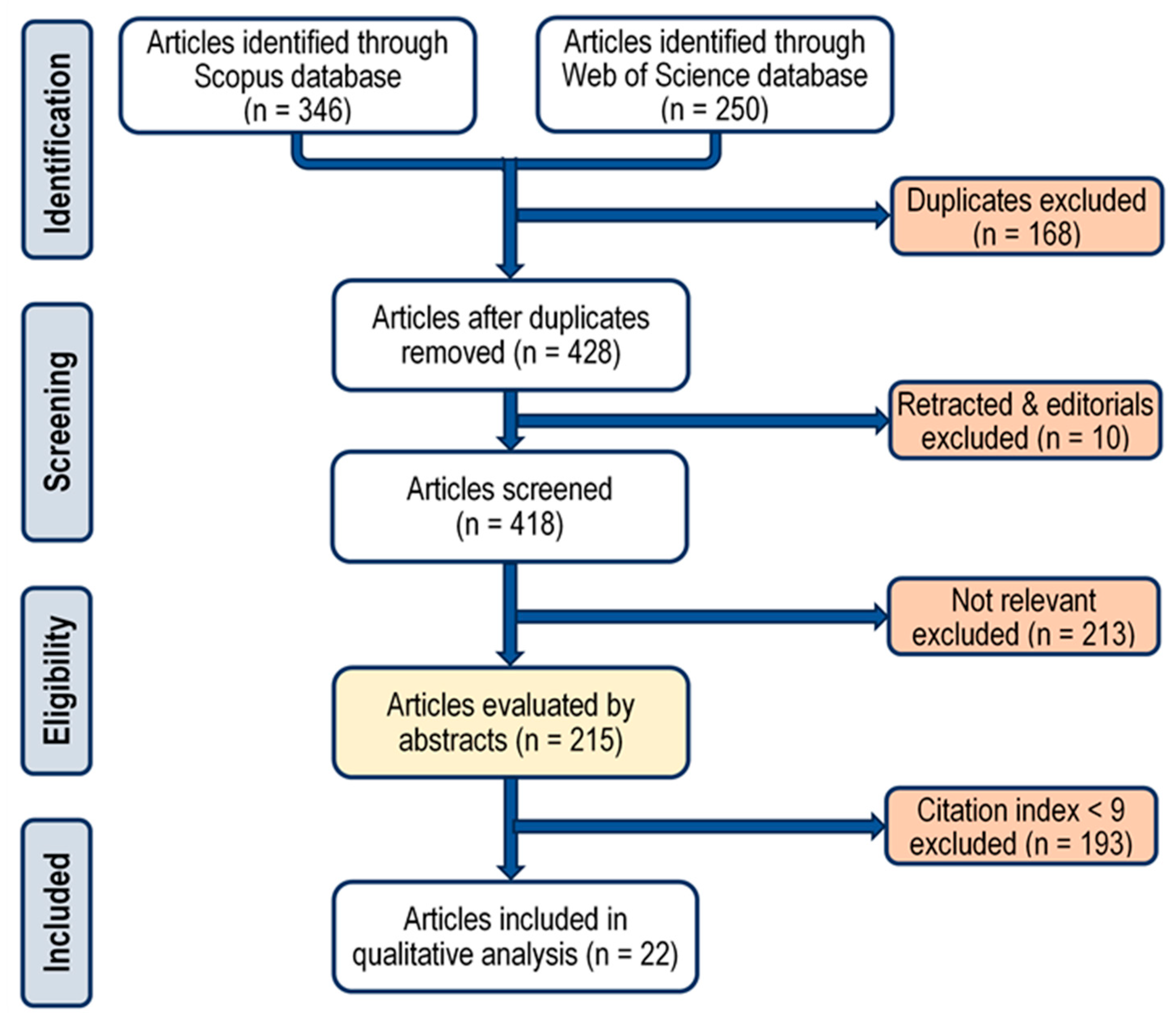
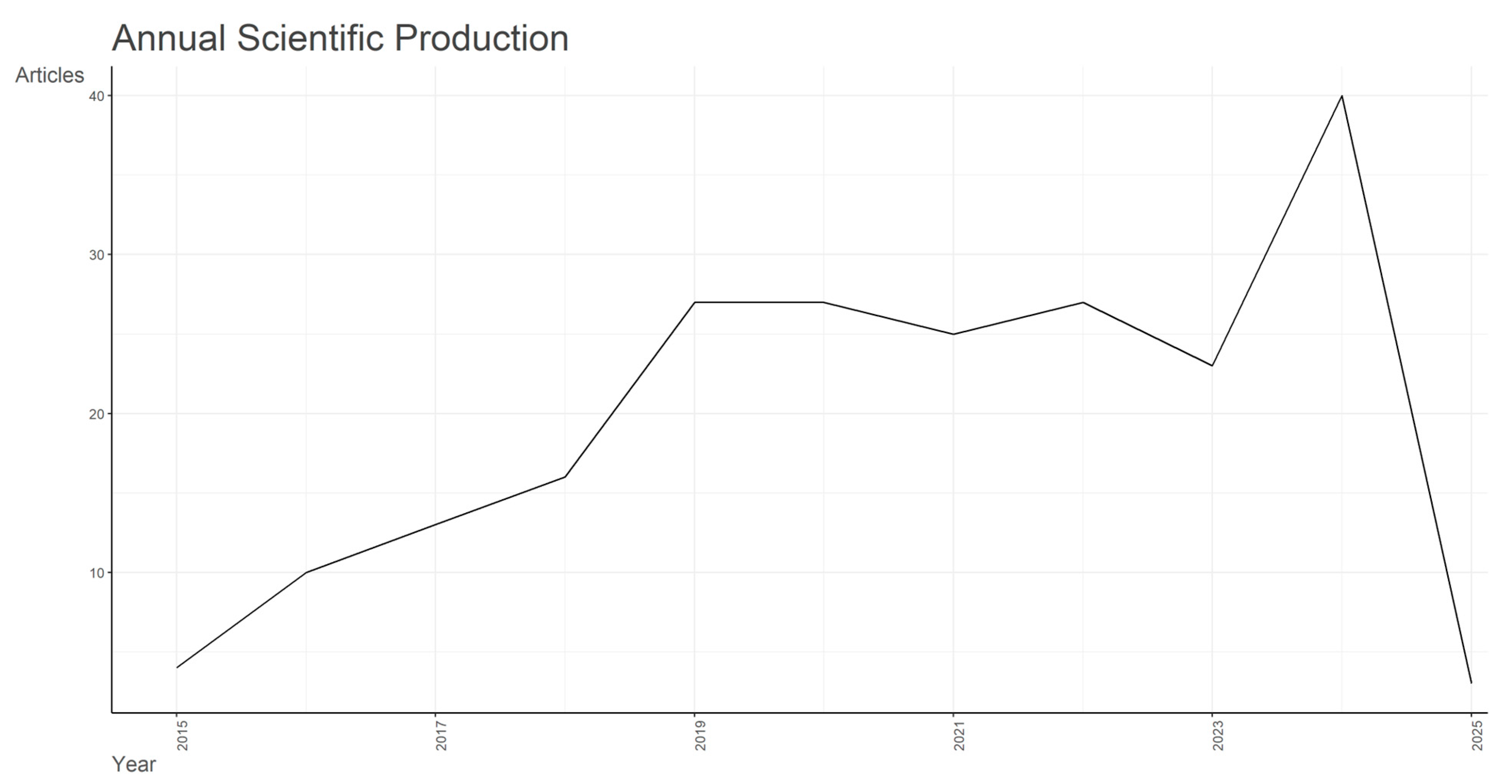
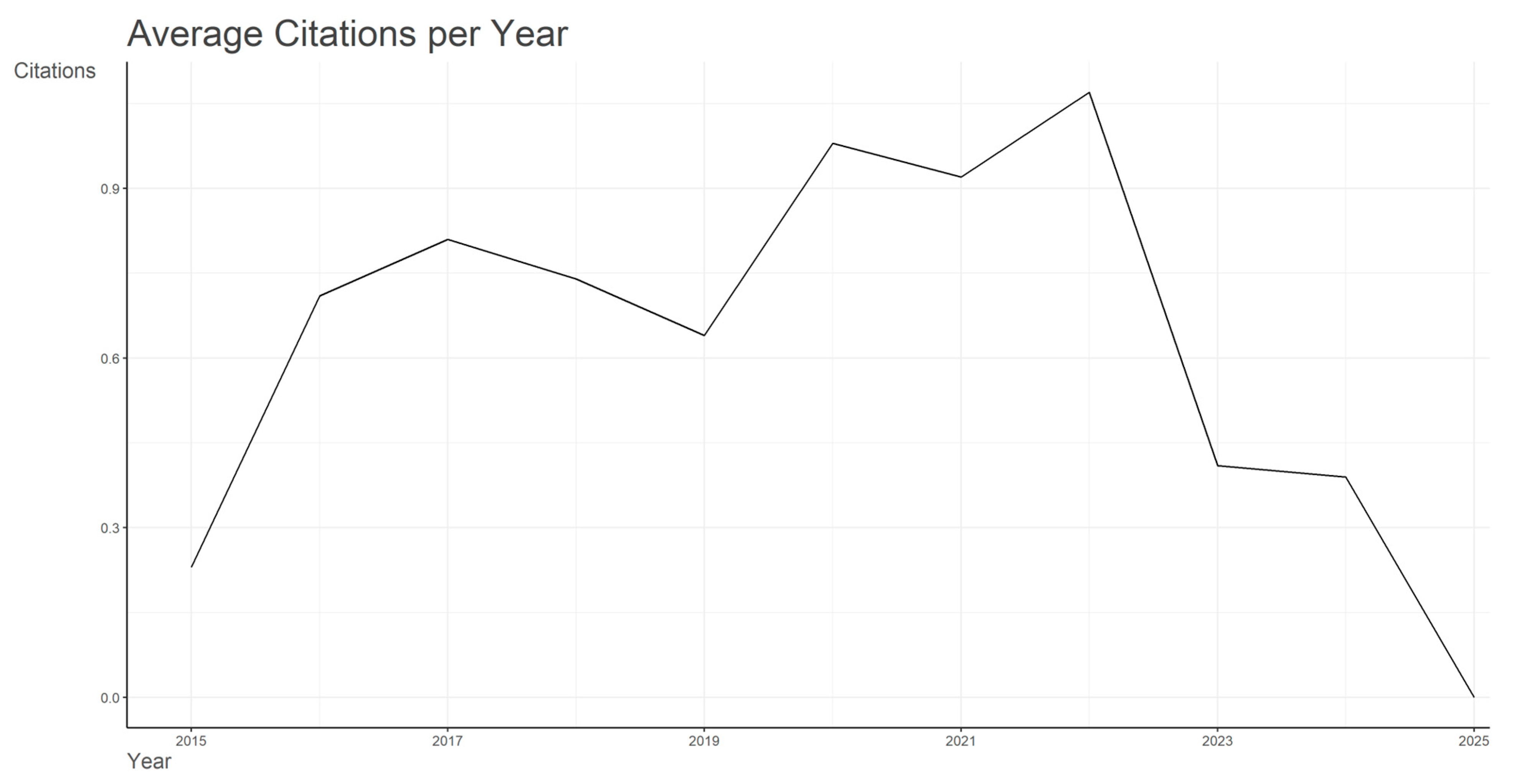


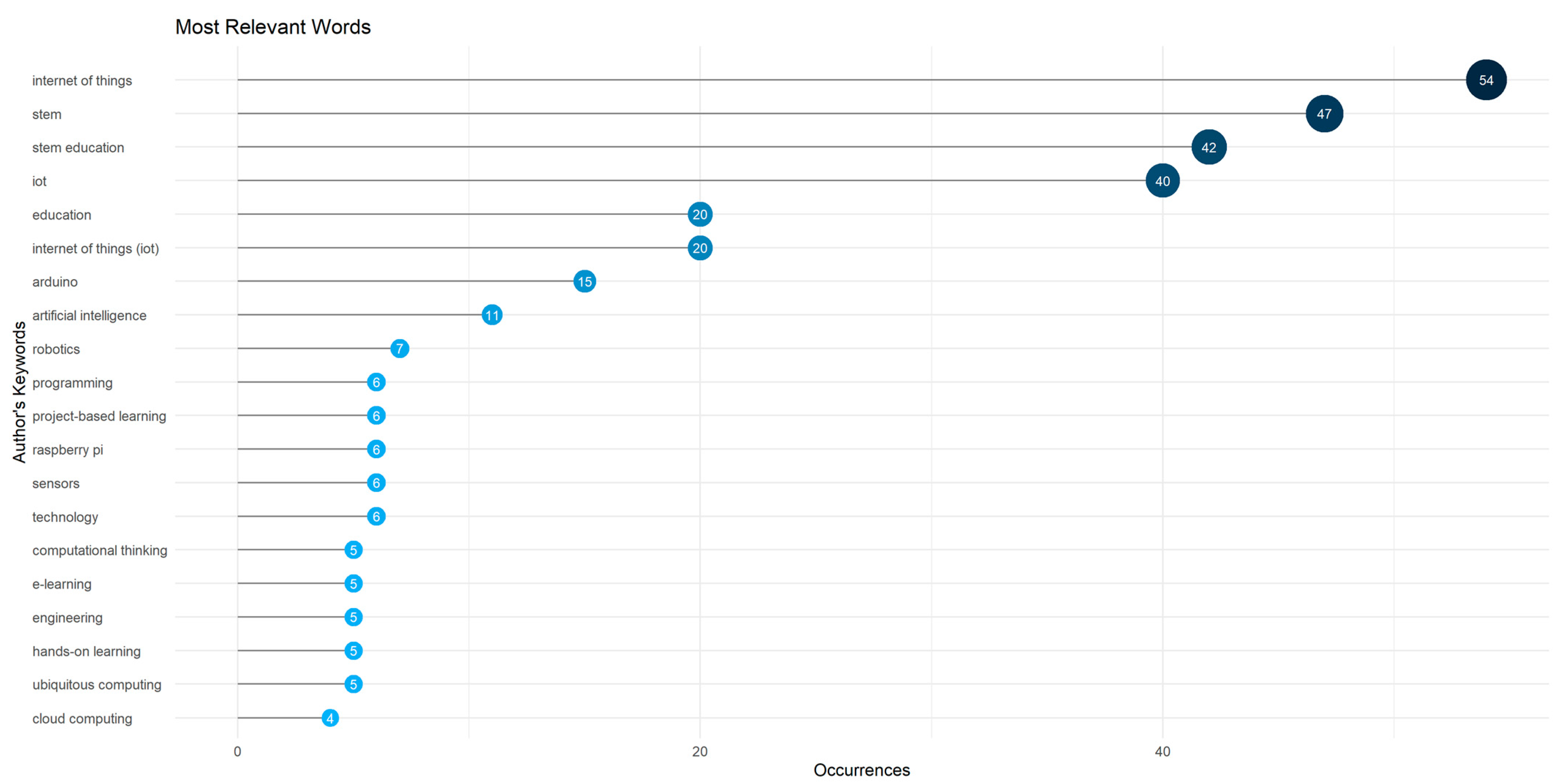

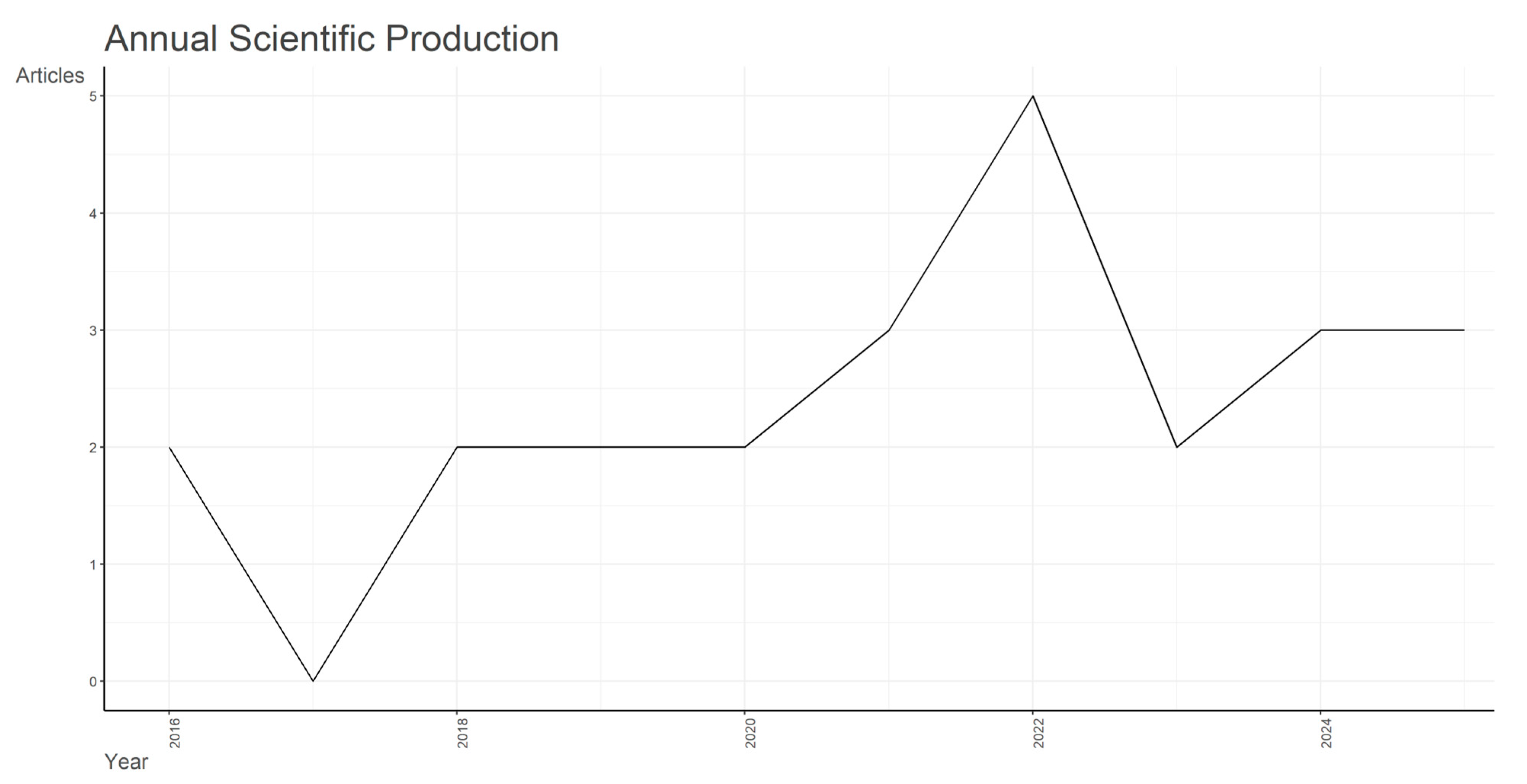


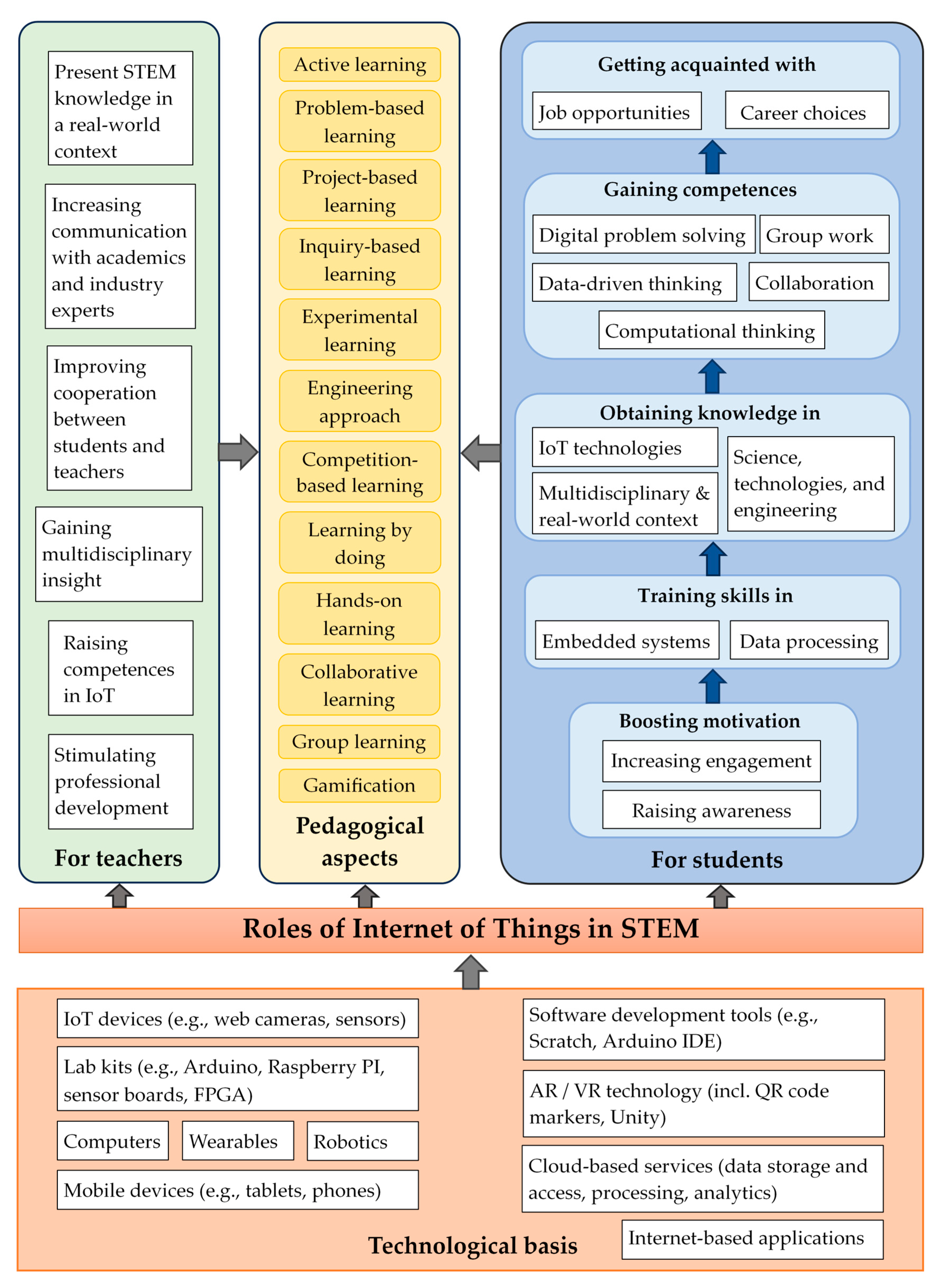

| Type of Criteria | Description of the Criteria |
|---|---|
| Inclusion criteria | Topics, such as Internet of Things (IoT); Science, Technology, Engineering, and Mathematics (STEM); teaching-learning process in STEM |
| IoT use in STEM educational approaches and instructional strategies | |
| Using IoT to make students aware of contemporary issues related to sustainability, energy efficiency, ecology, society, etc. | |
| IoT applications as a learning tool in STEM | |
| Security aspects of IoT in STEM | |
| Design of STEM courses using IoT | |
| Exclusion criteria | Containing the verb “stem” in the title, abstract, or authors’ keywords |
| IoT applications not in the educational context | |
| Aspects not focused on using IoT in STEM education (e.g., gender issues, business, and economics) | |
| General security aspects not related to IoT in STEM | |
| Citation index less than 9 |
| Description | Results for SQ1 | Results for SQ2 |
|---|---|---|
| MAIN INFORMATION ABOUT DATA | ||
| Timespan | 2015:2025 | 2016:2025 |
| Sources (Journals, Books, etc.) | 164 | 21 |
| Documents | 215 | 24 |
| Annual Growth Rate % | −2.84 | 4.61 |
| Document Average Age | 4.23 | 3.67 |
| Average citations per document | 3.902 | 14.04 |
| DOCUMENT CONTENTS | ||
| Keywords Plus (ID) | 806 | 118 |
| Author’s Keywords (DE) | 610 | 116 |
| AUTHORS | ||
| Authors | 643 | 91 |
| Authors of single-authored docs | 24 | 2 |
| AUTHORS COLLABORATION | ||
| Single-authored docs | 28 | 2 |
| Co-Authors per Document | 3.7 | 3.79 |
| International co-authorships % | 10.23 | 12.5 |
| DOCUMENT TYPES | ||
| article | 48 | 9 |
| article; early access | 1 | |
| book | 2 | |
| book chapter | 9 | |
| conference paper | 82 | 6 |
| proceedings paper | 71 | 6 |
| review | 2 | 3 |
| Year | MeanTCperArt | N | MeanTCperYear | CitableYears |
|---|---|---|---|---|
| 2015 | 2.50 | 4 | 0.23 | 11 |
| 2016 | 7.10 | 10 | 0.71 | 10 |
| 2017 | 7.31 | 13 | 0.81 | 9 |
| 2018 | 5.88 | 16 | 0.74 | 8 |
| 2019 | 4.48 | 27 | 0.64 | 7 |
| 2020 | 5.85 | 27 | 0.98 | 6 |
| 2021 | 4.60 | 25 | 0.92 | 5 |
| 2022 | 4.30 | 27 | 1.07 | 4 |
| 2023 | 1.22 | 23 | 0.41 | 3 |
| 2024 | 0.78 | 40 | 0.39 | 2 |
| Text in Title, Abstract, and Keywords | Count | Documents with the Terms | Percentage of Documents |
|---|---|---|---|
| engineering | 364 | 129 | 60.00% |
| process | 113 | 66 | 30.70% |
| sensor | 114 | 52 | 24.19% |
| robot | 207 | 46 | 21.40% |
| hands-on | 85 | 43 | 20.00% |
| programming | 110 | 37 | 17.21% |
| Arduino | 98 | 32 | 14.88% |
| artificial intelligence | 48 | 29 | 13.49% |
| microcontroller | 28 | 16 | 7.44% |
| temperature | 21 | 15 | 6.98% |
| project-based | 25 | 15 | 6.98% |
| raspberry | 23 | 14 | 6.51% |
| ubiquitous computing | 19 | 14 | 6.51% |
| hands-on learning | 21 | 13 | 6.05% |
| project-based learning | 21 | 13 | 6.05% |
| machine learning | 23 | 12 | 5.58% |
| computational thinking | 23 | 11 | 5.12% |
| kits | 20 | 10 | 4.65% |
| educational robotics | 18 | 10 | 4.65% |
| virtual reality | 16 | 9 | 4.19% |
| remote laborator* (-y, -ies, etc.) | 14 | 8 | 3.72% |
| augmented reality | 15 | 8 | 3.72% |
| experiential learning | 15 | 7 | 3.26% |
| humidity | 10 | 5 | 2.33% |
| smart schoolhouse | 19 | 5 | 2.33% |
| online learning | 7 | 4 | 1.86% |
| automatic control | 3 | 2 | 0.93% |
| Target Group Students | IoT Applications | Source |
|---|---|---|
| Kindergarten and preschool | Mockup IoT models and figures to sensitize children to the existence of various devices through pretend play | [41] |
| Elementary school students | Maker education, hands-on activities, and a personal project | [26] |
| Secondary school and pre-university students | Workshops encouraging the pursuit of careers in STEM; exploring STEM-based entrepreneurship attitudes; knowledge construction during learning by making in complex environments | [33,34,35] |
| Making students aware of environmental and societal issues via school projects involving IoT | [21,22] | |
| Hands-on and gamification for IoT-based educational tools | [22] | |
| Facilitating career choice by raising students’ awareness of IoT through hands-on activities | [25,36] | |
| University students | Hands-on laboratory-based approach using IoT, cloud computing, and blockchain applications | [24] |
| Project-driven STEM education | [39] |
| Reference | STEM Education Context | Teaching-Learning Approach | Used Technological Solution |
|---|---|---|---|
| Mylonas et al. [21] | To raise the awareness of students about issues of sustainability and energy efficiency through lab exercises | Laboratory exercises | Combination of IoT, (Arduino, Raspberry Pi, lab kits) and AR visualization. |
| Mylonas et al. [22] | To increase students’ motivation and engagement, To raise the awareness of students about energy saving and sustainability | Learning based on competition and gamification | Combination of IoT, Cloud-based services (GAIA Platform, Apache Storm) and Internet-based applications |
| Abichandani et al. [10] | To train skills related to sensor data acquisition and IoT | Problem-based learning, project-based learning, activity-based learning, inquiry-based learning, collaborative learning | Low-cost IoT hardware and open-source software, mainly home-automation projects |
| Rao et al. [24] | To raise the motivation and engagement of students by organizing hands-on laboratory courses | Hands-on multidisciplinary laboratory exercises | IoT in combination with cloud-based services |
| Spyropoulou et al. [25] | To make students acquainted with career choices and job opportunities in the STEM field | Hands-on group-based education activities | IoT lab kits and educational materials |
| Hollenstein et al. [41] | To make young children acquainted with digital processes and develop skills for digital problem solving | Smart play corners in kindergartens | Materials for pretend play (e.g., old laptops, wooden tablets) in play corners |
| Kamal et al. [27] | Students to gain knowledge and skills regarding IoT and blockchain technologies | Project-based learning | Learning kit with Arduino, Raspberry Pi, and cloud platform |
| Benita et al. [28] | To stimulate data-driven thinking | Experimental and collaborative learning | Smart learning ecosystem- IoT devices, cloud-based services, analytical platform |
| Cornetta et al. [29] | To improve usage of Fab labs for educational purposes, knowledge sharing, cooperation between students and teachers | Learning by doing | Fabrication-as-a-service (FaaS)—cloud-based hub and Fab labs distributed over a network |
| Glaroudis et al. [30] | To give knowledge in the field of IoT, mobile, and ubiquitous computing and to strive career in this area | Active, problem-driven, and collaborative learning | A toolset that integrates equipment for IoT, mobile and ubiquitous computing, collaborative educational environment, and suitable scenarios |
| Kusmin et al. [31] | To improve teachers’ and students’ competences in the IoT domain | Inquiry and project-based learning | Smart school house that is based on sensor kits (environmental sensors, cloth and body sensors, digital art sensors) |
| Tziortzioti et al. [23] | To obtain knowledge in science and technology and use it for solving real problems | Active learning | Water sensor IoT kit based on Arduino |
| Fidai et al. [32] | To inform STEM instructional leaders and policy makers about the advantages of open-source Arduino hardware and freely available Scratch software in STEM education | Hands-on engineering activities for K–12 and post-secondary classrooms | Open-source Arduino hardware and free Scratch software |
| Byrne et al. [33] | To encourage pre-university teenagers to pursue careers in STEM, with a particular emphasis on computer science | A week-long workshop, Collaborative, technology-mediated, and project-based learning | Wearables, Raspberry Pi, Arduino Uno, robotic vehicle chassis with onboard motor controller and Grove |
| Merino et al. [37] | Wireless Educational Platform approach to be included in STEM educational programs for school students | Collaborative development environment to promote the innovation and motivation of the students within a STEM context | Arduino, FPGA, robots |
| Shahin et al. 2021 [35] | To explore the effects of a one-day female-focused STEM-based entrepreneurship program on the entrepreneurial intention of secondary school female students | Exploring entrepreneurial attitudes in secondary school female students, two surveys to assess the effect of the program | IoT component using the micro:bit device |
| Charlton & Avramides [34] | To examine learning by doing as a medium for students to explore STEM, with a particular focus on computer science and engineering | Learning by doing, technology-enhanced learning, collaborative and problem-based learning | IoT, sensors, Arduino, Internet |
| Yeh et al. et al. [26] | To apply Maker education in STEM subjects; IoT as the curriculum development topic | Hands-on activities, practical actions, project-based learnings | Webduino Smart device embedded in the Esp8266 module, Webduino Blockly software |
| Makamure & Tsakeni [38] | To teach IoT-enabled STEM subjects in virtual classrooms based on Web 2.0 tools | Hands-on activities suitable to online teaching, experiments in online science laboratories, Teacher-centered instructional strategies | IoT infrastructure and gadgets that enable connectivity |
| Porter et al. [36] | To enable interaction with practicing professionals in authentic experiential environment | Learning activities and engineering design projects related to building automation | Programmable IoT, Building Monitoring Device (IBMD), Texas Instruments LaunchPad |
| Loukatos et al. [39] | To present basics of automatic control and hardware, software, and network principles to students in agricultural engineering | Project-based learning approach; Teamworking | Realistic size system remotely controlled by a tablet or smartphone built by simple components (Arduino, Raspberry Pi, IoT) and reused electrical equipment |
| Al-Masri et al. [40] | Overview of the current state of integration of hardware prototyping platforms and the context in which they are integrated into STEM and non-STEM education | Courses that integrate hardware prototyping platforms into learning technologies | Raspberry Pi, Arduino, BeagleBone Board |
Disclaimer/Publisher’s Note: The statements, opinions and data contained in all publications are solely those of the individual author(s) and contributor(s) and not of MDPI and/or the editor(s). MDPI and/or the editor(s) disclaim responsibility for any injury to people or property resulting from any ideas, methods, instructions or products referred to in the content. |
© 2025 by the authors. Licensee MDPI, Basel, Switzerland. This article is an open access article distributed under the terms and conditions of the Creative Commons Attribution (CC BY) license (https://creativecommons.org/licenses/by/4.0/).
Share and Cite
Terzieva, V.; Ivanova, M.; Djambazova, E.; Ilchev, S. The Role of Internet of Things and Security Aspects in STEM Education. Information 2025, 16, 533. https://doi.org/10.3390/info16070533
Terzieva V, Ivanova M, Djambazova E, Ilchev S. The Role of Internet of Things and Security Aspects in STEM Education. Information. 2025; 16(7):533. https://doi.org/10.3390/info16070533
Chicago/Turabian StyleTerzieva, Valentina, Malinka Ivanova, Edita Djambazova, and Svetozar Ilchev. 2025. "The Role of Internet of Things and Security Aspects in STEM Education" Information 16, no. 7: 533. https://doi.org/10.3390/info16070533
APA StyleTerzieva, V., Ivanova, M., Djambazova, E., & Ilchev, S. (2025). The Role of Internet of Things and Security Aspects in STEM Education. Information, 16(7), 533. https://doi.org/10.3390/info16070533








